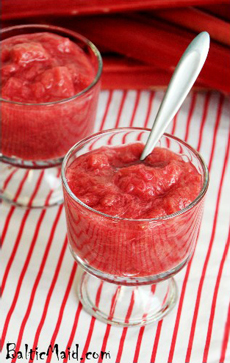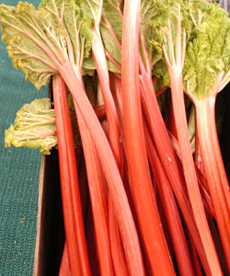TIP OF THE DAY: Ways To Enjoy Rhubarb
|
|
Spring is rhubarb season. It parallels asparagus season, available fresh for just three months a year—April through June. So make rhubarb while you can. Naturally tangy, this versatile vegetable can be used in savory sauces or cooked as a vegetable. When combined with sugar it pops into delicious desserts, which is why sweet rhubarb has become more popular than savory preparations. Rhubarb first grew wild in northwest China, and was cultivated as far back as 5,000 years ago, for medicinal purposes. Before it was first sweetened by British cooks in the Victorian era, it was added to soups, sauces and stews—Moroccan tagines and Middle Eastern stews, for example. The thinner and darker pink the fresh rhubarb stalks are, the sweeter they will be. When shopping for rhubarb, look for stalks that are crisp, bright pink, thin, and unblemished. Check your farmers markets and specialty food stores for rhubarb products, fresh-baked (pies, tarts) or prepared (chutneys, jams). At the grocer’s, Dry Soda makes a rhubarb flavor; rhubarb syrup to mix into drinks, on pancakes, etc. (you can also find strawberry rhubarb syrup). |
|
|
COOKING WITH RHUBARB Be sure to cook only the stems; the leaves are mildly toxic. Savory Uses For Rhubarb |
||
|
RECIPE: NANA’S STEWED RHUBARB
You can use soft and sweet stewed rhubarb by itself, with an optional topping of crème fraîche, sour cream or Greek yogurt. We also like it: This easy recipe requires only three ingredients—rhubarb, sugar, water and lemon juice—with optional flavorings (you can substitute a teaspoon of vanilla for the tablespoon of lemon juice). For a purée, like applesauce, run the cooked rhubarb through a food mill or food processor. Ingredients |
 A seasonal delight: sweet and tangy stewed rhubarb. Photo courtesy BalticMaid.com. |
|
|
Preparation 1. TRIM, wash and dice the rhubarb. Combine in a saucepan with the water, sugar, lemon juice and optional sliced berries. 2. BRING the water to a boil and then simmer over medium-low heat, stirring occasionally until the sugar dissolves and the mixture is slightly thickened and the rhubarb is is in threads (stringy), about 15 minutes. 3. COOL and chill or serve warm. Technically, rhubarb is a vegetable, a member of the sorrel family (the difference between fruits and vegetables). Native to Asia, rhubarb has long been used in Chinese medicine. Fruits carry their seeds inside; vegetable seeds scatter in the wind. You see seeds in an apple, avocado, cucumber and tomato, but not in broccoli, carrots or lettuce. Lacking sweetness doesn’t make it a vegetable. Rhubarb, Rheum rhabarbarum, is a vegetable in the family Polygonaceae. The leaf stalks (petioles) are crisp like celery with a strong, tart taste. Rhubarb looks like rosy-pink celery, but is no relation (celery is a member of the Apiaceae family). While rhubarb is botanically considered a vegetable, a New York court decided in 1947 that since it was used in the United States as a fruit, it counted as a fruit for the purposes of regulations and duties. A side effect was a reduction on imported rhubarb tariffs, as tariffs were higher for vegetables than fruits. [Source: Wikipedia] And that’s only one example. Science notwithstanding, on May 10, 1893, tomatoes, a red fruit/berry of the Nightshade family, were declared a vegetable by the United States Supreme Court. At the time, there were import tariffs on vegetables but not fruits, yet tomatoes were still being subjected to the tax. In 1887, an importing company had sued the tax collector of the Port of New York to recover back duties collected on their tomatoes, which they claimed had been wrongfully classified as vegetables. The Court decided that the tariff act should be based “in common language of people,” not botanists, so tomatoes should be taxed like potatoes, carrots, parsnips, turnips, beets etc. More proof that justice is blind.
|
||



